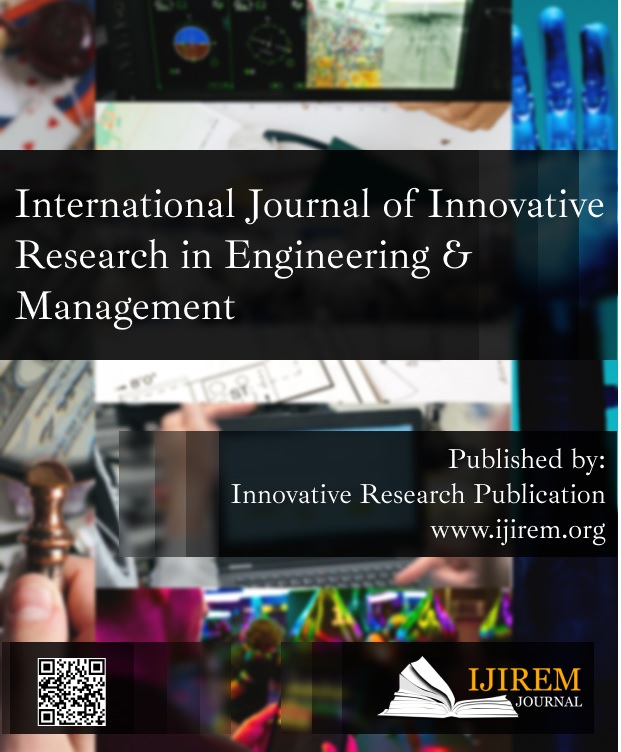Study of Solar Wind Hybrid Model at Leh Ladakh
Keywords:
Review of solar PV-wind hybrid system, Methodology used in the study, Modeling of PV wind hybrid system, Performance of PV- wind hybrid systemAbstract
Solar photo-voltaic system, with a reputation being inexhaustible and environmentally benign, has been widely used for power generation. The cost competitiveness of solar PV is likely to get even more obvious, particularly when compared with the continuous rising of conventional fuel prices and the rapid decline of PV module prices. Furthermore, the policies of India are conducive to the development of solar projects. But solar PV suffers from its intermittent characteristics.
Windmill produces power when the speed of wind blows beyond the cut-in speed. The kinetic energy of the wind is captured and by the application of the turbine and generator set, it converts into useful electrical energy. The energy output from this kind of power plants is dependent upon the wind speed. The proposed scheme integrates Solar PV and Windmills to increase the reliability of the power supply. As both solar PV and wind energy are intermittent, battery banks are placed to realize the reliability of the supply. The system operates on standalone mode. It is evident from various studies that, in the Leh, Ladakh region wind and Solar power production complement each other. During the summer season or sunny days, the Solar PV share a larger portion of generated power whereas in the winter season or cloudy day the large portion of power will be delivered by the Wind mill. The excess power after meeting the load demand will be stored in the battery bank and that stored energy will be utilized when the combined operation of Solar PV And Windmill are not able to meet the load demand. The proposed scheme evaluates the performance of such a scheme and aims to optimize the system.
Downloads
References
Kennan, N., & Vakeesan, D. (2016). Solar energy for future world: - A review. Renewable and Sustainable Energy Reviews, 62, 1092–1105.
Shafiee S, Topal E. When will fossil fuel reserves be diminished? Energy Policy 2009; 37(1):181-9.
Koroneos C, Spachos T, Moussiopoulos N. Exergy analysis of renewable energy sources. Renew Energy 2003;28(2):295–310.
IEA, International energy annual 2004. Energy Information Administration; 2006.
Raj A.K., Srivastava A.P., Dwivedi M. 2013 “Power plant engineering”, ISBN (13) : 978-81- 224-2333-4, New Age International (P) Ltd., publisher, New Delhi, India
Ostergaard PA, Sperling K. Towards sustainable energy planning and management. Int. J. Sustain Energy Plan Manage 2014;1-5.
Ma T, Yang H, Lu L. Study on stand-alone power supply options for an isolated community. Int J Electr Power Energy Syst 2015;65:1–11.
Alberg Ostergaard P, Mathiesen BV, Moller B, Lund H. A renewable energy scenario for Aalborg Municipality based on low-temperature geothermal heat, wind power and biomass. Energy 2010;35:4892–901.
Lund H, Munster E. Management of surplus electricity production from a fluctuating renewable-energy source. Appl Energy 2003;76:65–74.
Droste-Franke B, Paal B, Rehtanz C, Sauer D, Schneider J-P, Schreurs M, et al. Demand for balancing electrical energy and power. Balancing renewable electricity. Berlin, Heidelberg: Springer; 2012.
Ostergaard PA, Lund H. A renewable energy system in Frederikshavn using low temperature geothermal energy for district heating. Appl Energy 2011;88:479–87.
Fraunhofer-Gesellschaft. Managing renewable energy intelligently.ScienceDaily.
www.sciencedaily.com/releases/2014/03/140325094814.h tm [accessed 07.4.21].
Ostgaard PA. Comparing electricity, heat and biogas storages’ impacts on renewable energy integration. Energy 2012; 37:255–62.
Ma T, Yang H., Lu L., &Peng J., (2015). Pumped storage based standalone photovoltaic power generation system: Modelling and techno-economic optimization. Applied Energy, 137, 649-659.
[accessed May,2021]
Hamre Y et al. Techno-economical study of hybrid power system for a remote village in Algeria. Energy 2008;33(7):1128–36.
Sharma R, Tiwari GN. Technical performance evaluation of stand-alone photovoltaic array for outdoor field conditions of New Delhi. Apple Energy 2012; 92:644–52.
Cheel A, Tiwari GN. A case study of a typical 2.32 kWp stand-alone photovoltaic (SAPV) in composite climate of New Delhi (India). Appl Energy 2011;88(4):1415–26. [19] [accessed May,2021]
Chen H, Cong TN, Yang W, Tan C, Li Y, Ding Y. Progress in electrical energy storage system: a critical review. Prog Nat Sci 2009; 19:291e312.
Daim TU, Li X, Kim J, Simms S. Evaluation of energy storage technologies for integration with renewable electricity: quantifying expert opinions. EnvironInnovSoc Trans June 2012;3:29- 49.
European Commission. The future role and challenges of energy storage. In: DG ENER Work Pap; 2013.
Kocak K. Practical ways of evaluating wind speed persistence. Energy 2008;33: 65–70
Sahin AZ, Aksakal A. Wind power energy potential at the North-eastern region of Saudi Arabia. Renew Energy 1998;14:435–40
Liu LQ, Wang ZX, Zhang HG, Xue YC. Solar energy development in China – a review. Renewable and Sustainable Energy Reviews 2010; 14:301–11.
Kumar A, Kumar K, Kaushik N, Sharma S, Mishra S. Renewable energy in India: current status and future potentials. Renewable and Sustainable Energy Reviews 2010;14(October (8)):2434–42.
Ali R., Daut I., Taib S., &Jamoshid N. S. (2010, June). A new proposal to solar and gridconnected hybrid electricity for homes and buildings in Malaysia. In Power Engineering and Optimization Conference (PEOCO), 2010 4th International (pp. 445-448). IEEE.
Ma T., Yang H., & Lu L. (2015). Study on stand-alone power supply options for an isolated community. International Journal of Electrical Power & Energy Systems, 65, 1-11.
Blum N. U., Wakeling R. S., & Schmidt T. S. (2013). Rural electrification through village grids—Assessing the cost competitiveness of isolated renewable energy technologies in Indonesia. Renewable and Sustainable Energy Reviews, 22, 482-496.
Nema, P., Nema, R. K., &Rangnekar, S. (2009). A current and future state of art development of hybrid energy system using wind and PV-solar: A review. Renewable and Sustainable Energy Reviews, 13(8), 2096-2103.
Joselin Herbert, G. M., Iniyan, S., Sreevalsan, E., &Raja Pandian, S. (2007). A review of wind energy technologies. Renewable and Sustainable Energy Reviews, 11(6), 1117– 1145.
